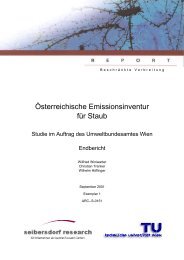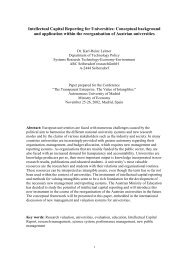ALPMON FINAL REPORT - ARC systems research
ALPMON FINAL REPORT - ARC systems research
ALPMON FINAL REPORT - ARC systems research
You also want an ePaper? Increase the reach of your titles
YUMPU automatically turns print PDFs into web optimized ePapers that Google loves.
Contract ENV4-CT96-0359 <strong>ALPMON</strong><br />
95% (Kappa 0.91) for the forest border.<br />
In more detail for some most relevant parameters: shrubs reached a mean class accuracy of 89%, for<br />
grassland it amounted to 92%. Furthermore, the mean deviation for the share of coniferous trees was<br />
only 7%, whereas the share of larch trees varied with 12% and tended to be underestimated.<br />
Additionally, visual interpretation of the classification results showed quite a realistic image, thus<br />
confirming the quality of the output.<br />
Implementation of a High Spatial Resolution Winter Image<br />
The separation of typical Alpine low growing tree species such as dwarf mountain pine and green alder<br />
(in general not higher than 2-3m) from high growing forest stands could not be reached with the<br />
classification of Landsat TM data from the vegetation period, because their spectral characteristics are<br />
very similar. For improving these results, a high spatial resolution IRS-1D panchromatic winter scene<br />
was analysed by way of example for a small sub-set of the Dachstein test site.<br />
The data acquisition time was from a period, where snow was covering the low growing tree species<br />
but has already fallen from the crowns and branches of the high growing trees. Through multi-seasonal<br />
classification it was possible to separate high growing from low growing trees with high accuracy. The<br />
classification accuracy of the high growing forest border was very high with a mean of 98% and a<br />
Kappa value of 0.95. With this approach also the dwarf mountain pine and green alder itself can be<br />
separated from each other.<br />
The data was also investigated with regard to their potential for detecting small gaps (approx. 50m 2 )<br />
within the forest, which has been defined as one important parameter for the assessment of avalanche<br />
risk. Due to the better spatial resolution of the winter-IRS-pan image there was also an advantage in<br />
detecting gaps/forest openings down to a size of 25-30 m². In classifications of the summer Landsat<br />
TM and SPOT data only a detection down to approximately 240 m² can be reached.<br />
In conclusion, the big advantages of the forest border derived from the IRS-1D panchromatic winter<br />
image are:<br />
� the separation of dwarf mountain pine and green alder from high growing forest stands,<br />
� the detection of small gaps within the forest due to the high ground resolution of 6m.<br />
2.3.3.5 Results<br />
The main outcome of the feasibility study on avalanche risk assessment are maps of the single<br />
parameters as defined in the requirement study. These parameters can be implemented in a region<br />
based avalanche risk model which requires information on land cover, especially vegetation and forest,<br />
and on topography. As no avalanche risk model was available within the course of this study, the<br />
implementation, unfortunately, could not be tested. Although many parametric requirements, and to<br />
some extent also their interdependencies, could be ascertained, the information yet is too<br />
heterogeneous, and in most cases too much related to a specific investigation area, to establish a<br />
comprehensive avalanche risk model.<br />
The classification results were plotted as maps with a scale of 1:50 000, corresponding to the Austrian<br />
Topographic Map, sheet 127 Schladming. They were overlaid with contour lines in order to enable a<br />
good orientation within the map. Areas affected by shadow in the satellite data were masked out and<br />
not classified. They covered 2% of the entire test site. Four maps were generated for land cover<br />
(including forest type and non forest classes), forest canopy closure, natural forest age, and more<br />
detailed forest types as required for the avalanche risk analysis. Additionally, for the area which was<br />
covered by the IRS-1D winter image, an even more detailed forest type classification is available,<br />
revealing dwarf mountain pine and green.<br />
To show an example for the possible combination of diverse risk parameters, in Figure 7 the forest<br />
canopy closure is shown only on slopes between 25° and 50°, as these are the slopes with potential for<br />
frequent avalanche release. As stated before, no rules for the combination of risk parameters were<br />
available, thus no risk analysis could be performed within the duration of this project. For assessing the<br />
potential avalanche risk zones, an hierarchical approach could be suggested, e.g. by first selecting only<br />
those areas with critical slope steepness, then within these areas the forests with critical canopy<br />
closure, and so on.<br />
JR, RSDE, ALU, LMU, Seibersdorf, WSL 41




